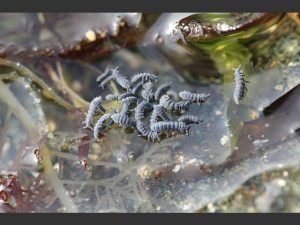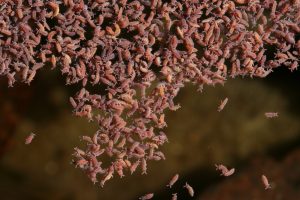What are Springtails?
Springtails are small insects that appear in large numbers in moist environments. They are sometimes mistaken for fleas due to the fact that they have the ability to jump to fairly long distances when disturbed. Unlike fleas, however, they do not bite humans or feed on blood.
How to Identify Springtails
Springtails are easy to identify. They have very tiny, wingless bodies, measuring as little as .25 mm. Their bodies are soft, slender, and feature two antennae. These jumpy fellows are also black, brown, or grey; though some species are clear in color or bluish-white.
Of note is the fact that springtail species feature a body part called furcula underneath the abdomen. This enables them to spring to about 4 inches if disturbed or threatened.
The Life Cycle of Springtails
Springtails have three distinct life stages: egg nymph and adult. Adult springtails lay their eggs in moist environments, particularly soil, where food is plentiful. Springtail pests eat algae, pollen, fungi, mold, and decaying plants. However, they will scavenge just about any organic material they can find in their surroundings.
Adult springtails usually come out in spring but can also be found throughout the year on vast terrains and locations which includes mountains and forests, beaches, Artic environments, gardens, the soil of potted house plants, or even in your basement. They especially love areas where soil is rich with compost, mulch or decaying leaves as this provides ideal moisture for eggs, nymphs, and adults to live. It takes about 5- 11 weeks for springtails to develop from egg to adult.
Special Characteristics of Springtails
The springtail’s special characteristic is its furcular, which it uses to propel itself in the air when threatened. This appendage on its body is only a fraction of a millimeter but strong enough to enable it to spring several inches into the air.
When springtail pests invade your home and spring about when disturbed, they can be a real nuisance as there are often hundreds of them gathered at any given time.
Signs of a Springtail Infestation

Shore or sea Springtails
Springtail insects invade homes in search of moisture. Due to the fact that they have soft bodies through which they breathe, they can easily lose moisture and die. During dry seasons or at times when moisture levels in their natural environment decrease, they will move towards finding alternative habitat, for instance, your home.
They crawl through cracks and crevices in search for a damp place to live. The fact that they are very small enables large numbers of them to infest homes at any given time. Since they can easily get through vent pipes and crawlspaces, homeowners may be caught by surprise when a springtail infestation hits.
Signs of infestation include the following:
- Dead springtails floating on the surface of swimming pools
- Springtail nymphs or adults in damp corners, basement, underneath sinks
- Springtails (dead or alive) in bathtubs or sinks
Removal and Preventative Procedures of Springtails
Homeowners and gardeners can protect themselves from springtail infestation as well as treat infestation in cases where springtails are present. To reduce risks of springtails invading your home or garden, apply the following measures:
- Fix leaks in kitchens, basements or bathrooms
- Reduce moisture levels by using a dehumidifier
- Caulk cracks or openings around utility lines
- Repair screens used at windows and doors
- Ensure basement vents are protected
- Seal all openings or entryways
- Control moisture levels in garden and surroundings by implementing irrigation control
- Remove mulch, damp wood, or leaf litter that might attract springtails
- Develop improved drainage system for your garden or landscape
- Avoid overwatering houseplants
If springtail infestation has already occurred, you may reduce the pest population by first reducing moisture in your home. Be sure to air and dry out infested areas as the springtail insects will quickly die when the moisture level is

Springtails jumping in groups
reduced.
You may also vacuum smaller populations of springtails and thereby remove them from your home. For removal of springtails in swimming pools, use a swimming pool filter or skimmer as well.
Instore or Chemical
Springtail infestation within your home or garden is best controlled by reducing moisture levels. But in some cases, you may feel so overwhelmed by a large number of insects present that chemical treatment seems like the best option.
Be very cautious before purchasing pesticides as many are useless when combating this type of pest infestation. For best results, seek help from a pest control expert before using pyrethroid insecticides or other chemical products.

No Comments